The Wagyu Beef Project
In my quest to sample the most exotic foods I never got to try while I was a vegetarian (long story there), I jumped on a co-worker’s plan to purchase and consume Japanese Wagyu beef, better known to most as Kobe beef (though ours wasn’t technically Kobe beef). I figured since so much money was spent on the beef, that we should, in some way, document it. Say, posting it on a blog, or something.
First of all, you might be wondering if I really paid hundreds of dollars for steak. Let’s just say that some betting and some sports teams were involved. Now, about the beef:
Japanese Wagyu refers to breeds of cattle predisposed to serious fat marbling. The resulting beef is so full of fat that it appears pink. It’s considered a gourmet item and is very expensive — so much so that if you’re eating a “Kobe beef” burger at some fancy place in the U.S., it had better cost you over $40 for the burger alone, otherwise, you’re eating neither Kobe nor Wagyu beef.
Kobe is the capital of Japan’s Hyogo Prefecture. Japanese beef (Wagyu) is grown in many regions of Japan, but the beef from Kobe is of the strictest standards. Also, there’s little pasture land in the Kobe region, so cattle get little freedom of movement. With the current demand for Kobe-style beef, the cattle are often raised in North America and then shipped back to Japan for certification and slaughter, only to be shipped back to N.A. for consumption.
Some more information on Wagyu is available online. Here’s a link to Wikipedia: http://en.wikipedia.org/wiki/Wagyu
It’s actually cheaper to buy Wagyu beef in North America, though you make some sacrifices. Canadian Wagyu is cross-bred with Angus, and this, combined with the different raising techniques produces a beef that is much less marbled than traditional Kobe/Wagyu. It’s also less than half the price per pound, which makes it a lot more attractive.
Here’s a sample of the marbling of different cuts of meat:
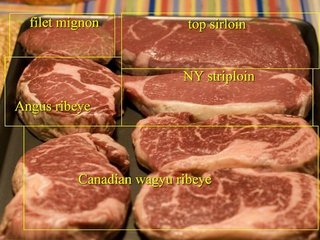
Notice how the Canadian Wagyu ribeye is more marbled (i.e. contains more intramuscular fat) than the other cuts, but much less so than the Wagyu ribeye. You may be thinking: “Eeewww, gross, look at all that fat,” but the big rule in cooking still stands with FAT = FLAVOUR. This is an important rule, as you can ruin Wagyu beef by overcooking.
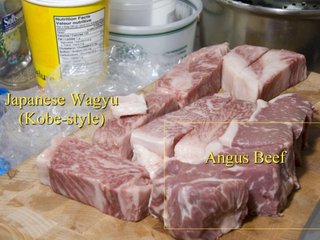
Our sample came from Pusateri’s in Toronto. It was certified Japanese Wagyu. Ours was a Japanese Black steer from the Gunma region. A-5 grade (the highest); beef marbling standard of about 11-12. For information on marbling standards, click on the following link:
http://www.blackmorewagyu.com.au/wagyu/pdfs/Japanese-Carcass-Grading-Standards.pdf
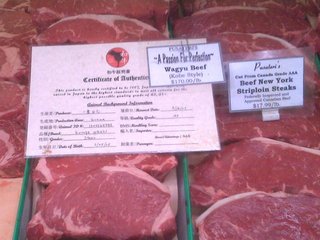
Yes, that’s $319.60 for a ~2lb. ribeye steak.
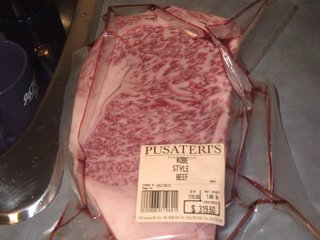
The steak was brought to room temperature before grilling. This is important, since we weren’t cooking it for very long. The excess gristle was trimmed off and repackaged to be later rendered. No part of this steak went to waste.
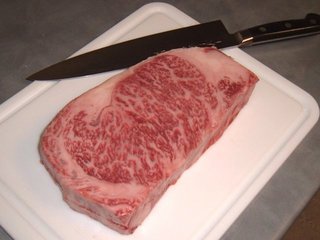
It was about 2 inches thick, and the “chef” carved it up into small fillets and even thinner slices (1/4″) for sashimi. Yes, Wagyu beef is occasionally found served up raw in sashimi and sushi dishes. In San Francisco, at the Isobune Sushi house, you can order Kobe beef sashimi. It costs extra, and is made on demand, rather than endlessly circling the table on a little wooden boat.
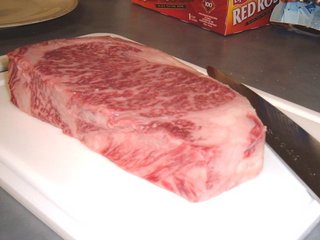
We kept the price tag to remind us not to ever do this again.
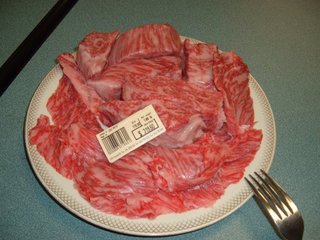
Here’s a big closeup of the intense marbling effect on the beef. The fat threatened to melt even at room temperature. This is what made cooking the beef tricky. The sashimi slices were eaten raw, or were spread out on top of steamed rice. This actually cooked the thin slices enough to make them palatable.
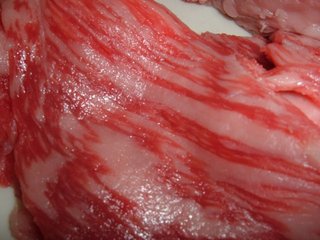
We also had some miso soup. It complemented the meat-heavy meal.
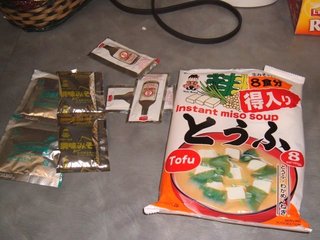
The larger fillets were placed on a hot barbecue and turned just enough to char the outside of the beef. 4 minutes per side. That’s 8 minutes total, not 16 — even though the fillets were roughly square on 4 sides, just one flip.
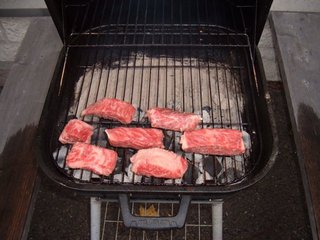
Too long on the barbecue, and the fat melts, drips away, and you’re left with very dry, rubbery, tasteless, and unremarkable meat. Too often Wagyu gets overcooked, and money is wasted. Lots of money.
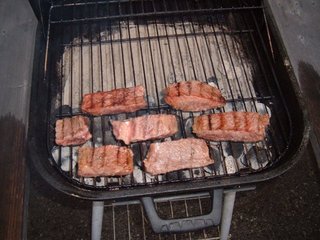
This overcooking illustrates a problem with Kobe beef burgers at restaurants. Most restaurants won’t cook a rare hamburger for fear of violating food safety standards. Yet Kobe beef doesn’t lend itself well to overcooking. My thinking is that Kobe burgers are a big scam.
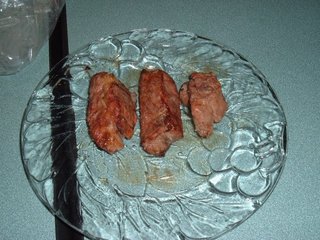
If all goes well, the final result is beef that resembles grilled Ahi tuna steaks. If you are a fan of medium to well-done steak, stay away from this. Also avoid grilled Ahi tuna. And sushi … stay away from that too.
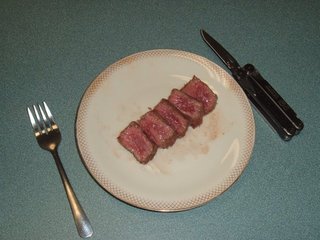
If only we’d prepared this in a proper kitchen, instead of at the office, I’d have been able to put proper garnishes on the plate, and made everything more presentable.
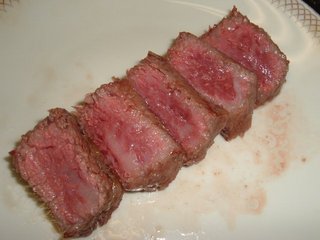
OK, but what did it taste like? Imagine eating the most tender ribeye steak imaginable; the kind of steak that whenever you find a piece of gristle you’d normally trim around, it would melt away in your mouth. Imagine the same ribeye being marinated in bacon grease (or beef grease, in this case). Your mouth gets coated in fat, and the beefy taste lingers long after the piece is gone. The thin sashimi strips were more tender than fatty tuna from a sushi house. And they tasted more like room temperature bacon grease — good, but weird; you know you’re doing something wrong, yet you don’t feel too bad about it.
So, is it bad for you? I don’t know. You really get the feeling that yes, it is very bad for you. Yet it’s comparatively low in saturated fats. The increased marbling and the way the beef is raised give it a higher omega fatty acid content than regular beef. The fat content also left me feeling really full after eating a small amount, so you wouldn’t be prone to overeating this beef.
I’m not saying you should eat it every day, in fact, at these prices, I’m not saying you should eat it at all. If I were to try this again, I might go with something much less fatty. I’d be more willing to spend $40/lb on some Canadian Wagyu that’s got some Angus in it. That might make a great barbecue meal. But it’s still pretty expensive for a steak. I have a hard time justifying a $50 bottle of scotch, so a $90 steak seems criminal.

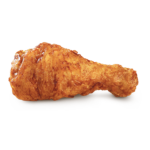 Previous Post
Previous Post
True Kobe is worth every dime man. Even Canadian Wagyu is worth it. I was raised in Alberta and have a high regard for steak – so when you have the chance to taste the Bentley of meats, you had better take it. Damn delicious!
Any idea what they feed them?
All Grass? Corn/Grass mix?
I believe it’s a combination of soy bean, wheat, and other grains.
We tried another Wagyu steak again this past weekend. This time on a gas barbecue. It was only a one-pounder, so about half as thick as the one pictured above. One friend who was a first-timer thought it was too weird, and kind of picked at it. R tried a few of the thin strips afterwards, and proclaimed it to fatty to enjoy properly.
I’m betting on a Canadian Wagyu ribeye instead. I’m betting it will have just the right mix of fattiness and substance. Later this Spring, we plan on having a proper comparison of different beef types, as well as different beef cuts. I should have more pictures then.
They definately feed them the traditional grass and grains that all cows eat, but what makes Wagyu and Kobe meats so ingrained with fat is a secret ingredient. BEER! They feed the cows beer or a malt liquor with their regular food at every feeding.
I like your blog entry about your wagyu experience. Let me know if you are interested in having it featured on my website or have a link to it. Please email me for further details.
Cash Cow [Wagyu] Investment Opportunities in Japan
Hello Everyone,
I can’t help but notice all the hype about wagyu despite the fact that most seem to agree that most of you are kind of out there supporting each other in a market where it is very hard or where profit margins are very small. I live here in Japan where owning wagyu is just not that big of a deal even though calves go for $3500.00 each (and expected to sky rocket with more import restrictions on the way). Feed cost run about $100.00 for cow and calf, but it is a very profitable business for any farmer here and the market is unlimited. As you know, Japanese like to make all kinds of things and sell them to everyone else, yet buy nothing from anyone. This creates the prefect opportunity for us farmers because Japan only imports as much beef as it cannot produce itself (to feed its people). I have decided to provide investment opprotunities for persons outside of Japan; I can own wagyu in Japan because I am a perminant resident and land owner.
Please view the information list on this site and contact me from there, if you are interested in investing in cattle that can be sold at 7-10 times the price of Wagyu in the United States.
Have a great day
Roger D. Johnson
Managing Director
International Wagyu